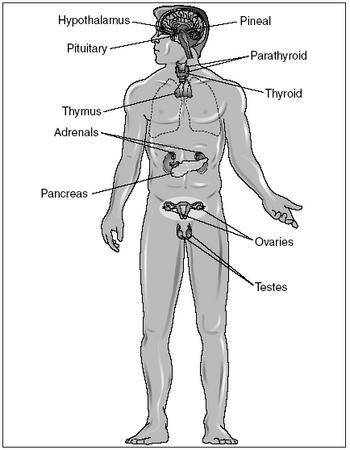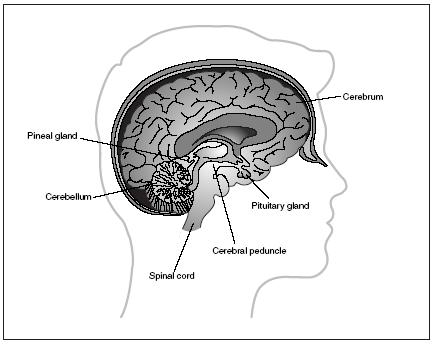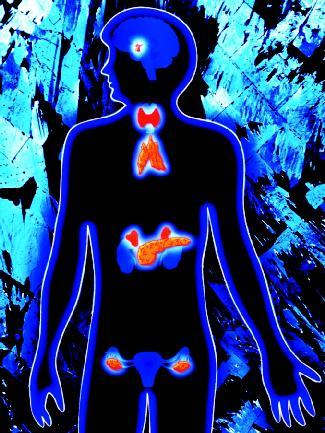The Endocrine System - Design: parts of the endocrine system
Glands are any organs that either secrete substances for further use in the body or excrete substances for elimination. Those that excrete substances for elimination are called exocrine glands ( exo means "outside"). Exocrine glands have ducts or tubes that carry their secretions to the surface of the skin or into body cavities. Sweat glands and the liver are examples of exocrine glands.
Endocrine glands ( endo means "inside") secrete or release substances that are used in the body. These glands lack ducts, releasing their secretions directly into the surrounding tissues and blood. Those secretions—hormones—then travel in the cardiovascular system to various points throughout the body.
The word hormone comes from a Greek word meaning "to arouse" or "to set in motion." Hormones control or coordinate the activities of other tissues, organs, and organ systems in the body. Most hormones are composed of amino acids, the building blocks of proteins. The smaller class of hormones are steroids, which are built from molecules of cholesterol (fat-like substance produced by the liver).
- Adrenal cortex (ah-DREE-nul KOR-tex):
- Outer layer of the adrenal glands, which secretes cortisol and aldosterone.
- Adrenal glands (ah-DREE-nul):
- Glands located on top of each kidney consisting of an outer layer (adrenal cortex) and an inner layer (adrenal medulla).
- Adrenal medulla (ah-DREE-nul muh-DUH-luh):
- Inner layer of the adrenal glands, which secretes epinephrine and norepinephrine.
- Adrenocorticotropic hormone (ah-dree-no-kor-tikoh-TROH-pik):
- Hormone secreted by the anterior pituitary that stimulates the adrenal cortex to secrete cortisol.
- Aldosterone (al-DOS-te-rone):
- Hormone secreted by the adrenal cortex that controls the salt and water balance in the body.
- Androgens (AN-dro-jens):
- Hormones that control male secondary sex characteristics.
- Antidiuretic hormone (an-tee-die-yu-REH-tik HOR-mone):
- Hormone produced by the hypothalamus and stored in the posterior pituitary that increases the absorption of water by the kidneys.
- Calcitonin (kal-si-TOE-nin):
- Hormone secreted by the thyroid gland that decreases calcium levels in the blood.
- Cortisol (KOR-ti-sol):
- Hormone secreted by the adrenal cortex that promotes the body's efficient use of nutrients during stressful situations.
- Epinephrine (ep-i-NEFF-rin):
- Also called adrenaline, a hormone secreted by the adrenal medulla that stimulates the body to react to stressful situations.
- Estrogens (ES-tro-jenz):
- Female steroid hormones secreted by the ovaries that bring about the secondary sex characteristics and regulate the female reproductive cycle.
- Gland:
- Any organ that secretes or excretes substances for further use in the body or for elimination.
- Glucagon (GLUE-ka-gon):
- Hormone secreted by the islets of Langerhans that raises the level of sugar in the blood.
- Gonad (GO-nad):
- Sex organ in which reproductive cells develop.
- Gonadotropic hormones (gon-ah-do-TROP-ik):
- Hormones secreted by the anterior pituitary that affect or stimulate the growth or activity of the gonads.
- Homeostasis (hoe-me-o-STAY-sis):
- Ability of the body or a cell to maintain the internal balance of its functions, such as steady temperature, regardless of outside conditions.
- Hypothalamus (hi-po-THAL-ah-mus):
- Region of the brain containing many control centers for body functions and emotions; also regulates the pituitary gland's secretions.
- Insulin (IN-suh-lin):
- Hormone secreted by the islets of Langerhans that regulates the amount of sugar in the blood.
- Islets of Langerhans (EYE-lets of LAHNG-er-hanz):
- Endocrine cells of the pancreas that secrete insulin and glucagon.
- Luteinizing hormone (loo-tee-in-EYE-zing):
- Gonadotropic hormone secreted by the anterior pituitary that stimulates, in women, ovulation and the release of estrogens and progesterone by the ovaries and, in men, the secretion of testosterone by the testes.
- Melatonin (mel-a-TOE-nin):
- Hormone secreted by the pineal gland that helps set the body's twenty-four-hour clock and plays a role in the timing of puberty and sexual development.
- Metabolism (muh-TAB-uh-lizm):
- Sum of all the physiological processes by which an organism maintains life.
- Negative feedback:
- Control system in which a stimulus initiates a response that reduces the stimulus, thereby stopping the response.
- Norepinephrine (nor-ep-i-NEFF-rin):
- Also called noradrenaline, a hormone secreted by the adrenal medulla that raises blood pressure during stressful situations.
- Ovaries (O-var-eez):
- Female gonads in which ova (eggs) are produced and that secrete estrogens and progesterone.
- Oxytocin (ahk-si-TOE-sin):
- Hormone produced by the hypothalamus and stored in the posterior pituitary that stimulates contraction of the uterus during childbirth and secretion of milk during nursing.
- Parathyroid glands (pair-ah-THIGH-roid):
- Four small glands located on the posterior surface of the thyroid gland that regulate calcium levels in the blood.
- Pineal gland (PIN-ee-al):
- Gland located deep in the rear portion of the brain that helps establish the body's day-night cycle.
- Pituitary gland (pi-TOO-i-tair-ee):
- Gland located below the hypothalamus that controls and coordinates the secretions of other endocrine glands.
- Progesterone (pro-JESS-te-rone):
- Female steroid hormone secreted by the ovaries that makes the uterus more ready to receive a fertilized ovum or egg.
- Prolactin (pro-LAK-tin):
- Gonadotropic hormone secreted by the anterior pituitary that stimulates the mammary glands to produce milk.
- Testes (TESS-teez):
- Male gonads that produce sperm cells and secrete testosterone.
- Testosterone (tess-TAHS-ter-ohn):
- Hormone secreted by the testes that spurs the growth of the male reproductive organs and secondary sex characteristics.
- Thymosin (thigh-MOE-sin):
- Hormone secreted by the thymus that changes a certain group of lymphocytes into germ-fighting T cells.
- Thymus (THIGH-mus):
- Glandular organ consisting of lymphoid tissue located behind the top of the breastbone that produces specialized lymphocytes; reaches maximum development in early childhood and is almost absent in adults.
- Thyroid gland (THIGH-roid):
- Gland wrapped around the front and sides of the trachea at the base of the throat just below the larynx that affects growth and metabolism.
- Thyroxine (thigh-ROK-seen):
- Hormone secreted by the thyroid gland that regulates the rate of metabolism and, in children, affects growth.
Each type of hormone affects only specific tissue cells or organs, called target cells or target organs. Each target cell has receptors on its membrane or inside of it to which a particular hormone can attach or bind. Only once this binding has occurred does the hormone bring about a change in the workings of a cell. Some hormones affect nearly every cell in the body; others affect only a single organ. Some cells have numerous receptors, acting as a target cell for many different hormones.
Unlike the organs or parts of other body systems, the principal endocrine glands are not physically connected together, but are scattered throughout the body. Located in the skull are the hypothalamus, pituitary gland, and pineal gland; in the throat are the thyroid gland and parathyroid glands; in the upper part of the chest is the thymus; in the abdominal region are the

pancreas and adrenal glands; in the pelvis of females are the ovaries; and in the scrotum of males are the testes.
Most of the endocrine glands serve only the endocrine system, but a few serve other systems as well. For this reason, they are called mixed glands. The pancreas is also a part of the digestive system because it secretes pancreatic juice into the small intestine (see chapter 2). The ovaries and testes are also part of the reproductive system because they produce gametes or the male and female reproductive cells—sperm cells and ova (see chapter 8). The thymus is also part of the lymphatic system because it helps a certain class of white blood cells to develop in order to fight germs and other foreign invaders (see chapter 5).
The hypothalamus
The hypothalamus is not a gland, but a small region of the brain containing many control centers for body functions and emotions. Composed of gray matter (brain tissue consisting of nerve cells that lack inner protective coverings), it is about the size of an almond and weighs only about 1/300 of the total mass of the brain.
The hypothalamus is often considered a part of the endocrine system for a number of reasons. It sends signals to the adrenal glands to release the hormones epinephrine and norepinephrine. It also produces its own hormones: antidiuretic hormone (ADH), oxytocin, and regulatory hormones. Both ADH and oxytocin are stored in the posterior pituitary gland until the hypothalamus sends nerve signals to the pituitary to release them. Regulatory hormones are divided into two classes: releasing hormones (RH) and inhibiting hormones (IH). Both types control the release of hormones by the pituitary gland. RH stimulate the production of pituitary hormones; IH inhibit or prevent the release of pituitary hormones.
The pituitary gland
Located at the base of the brain behind the nose, the pituitary gland is a small, oval gland approximately the size of a grape. It hangs by a thin piece of tissue from the interior surface of the hypothalamus. The pituitary is divided into two distinct lobes or regions: the anterior pituitary (the front lobe) and the posterior pituitary (the rear lobe). The anterior pituitary produces and secretes six hormones. The posterior pituitary secretes two hormones, but does not produce them. Those hormones are made by the hypothalamus, which uses the posterior pituitary as a storage area for the hormones until they are needed.
Six of the eight hormones released by the pituitary stimulate or "turn on" other endocrine glands. For this reason, they are referred to as tropic hormones (tropic comes from the Greek word tropos , meaning "to turn" or "change"). The remaining two hormones control other bodily functions. Because the pituitary's secretions control and regulate the secretions of other endocrine glands, it is often called the "master gland" of the endocrine system.
For some time, medical researchers have known that the hypothalamus controls the actions of the pituitary gland. Up until the late 1960s, however, they could not explain exactly how. In 1968, French-born American endocrinologist Roger Guillemin (1924– ) and others finally answered that unresolved question: hormones.
Prior to this discovery, English anatomist Geoffrey W. Harris had hypothesized that the hypothalamus releases hormones that regulate the pituitary gland. Harris and others, though, could not isolate and identify any hormones coming from the hypothalamus.
In the 1950s, Guillemin began an investigation to find the missing evidence. Working with fellow endocrinologist Andrew V. Schally, Guillemin used a tool developed by physicist Rosalyn Sussman Yalow to isolate and identify the chemical structure of hormones. Soon, Guillemin and Schally ended their scientific cooperation, pursuing their investigations separately.
Finally in 1968, while working with hypothalamic fragments from sheep brains, Guillemin and his coworkers isolated the hypothalamic hormone that causes the pituitary to release thyroid-stimulating hormone (TSH). The following year, both Guillemin and Schally identified the chemical structure of TSH. Guillemin then went on to isolate and determine the chemical structure of other hypothalamic hormones.
For their discoveries, which led to an understanding of the hormone produced by the hypothalamus, Guillemin, Schally, and Yalow shared the 1977 Nobel Prize for physiology or medicine.
The pineal gland
The pineal gland or body is a small cone-shaped gland located deep in the rear portion of the brain (pineal comes from the Latin word "pinea," meaning "pine cone"). Scientists are still somewhat mystified as to the endocrine function of this gland, which secretes the hormone melatonin.
The thyroid gland
One of the largest endocrine glands in the body, the thyroid gland is a butterfly-shaped gland that wraps around the front and sides of the trachea (windpipe) at the base of the throat just below the larynx (upper part of the trachea containing the vocal cords). It is divided into two lobes connected by a band of tissue called the isthmus. Because the thyroid contains a large number of blood vessels, it is deep red in color.
The thyroid gland is composed of hollow, spherical structures called thyroid follicles. The follicles release two main hormones, thyroxine and calcitonin. Thyroxine regulates the rate of metabolism and, in children, affects growth. Calcitonin decreases calcium levels in the blood.

The parathyroid glands
The parathyroid glands are four tiny masses of glandular tissue, each about the size of a pea, located on the posterior or rear surface of the thyroid gland (two on the back of each lobe). The parathyroids secrete parathyroid hormone (PTH) or parathormone, which controls the level of calcium in the blood.
The thymus
The thymus is a soft, flattened, pinkish-gray mass of lymphoid tissue located in the upper chest under the breastbone. In a fetus and newborn infant, the thymus is relatively large (about the size of an infant's fist). Up until about the age of puberty, the thymus continues to grow. After this point
in life, it shrinks and gradually blends in with the surrounding tissue. Very little thymus tissue is found in adults.
The thymus secretes several hormones that are known collectively as thymosins. Thymosins help change a certain group of white blood cells called lymphocytes into T cells, which are programmed to attack any foreign substance in the body.
The pancreas
The pancreas is a soft, pink, triangular-shaped gland that measures about 6 inches (15 centimeters) in length. It lies behind the stomach, extending from the curve of the duodenum (first part of the small intestine) to the
spleen. Primarily a digestive organ, the pancreas secretes pancreatic juice into the duodenum through the pancreatic duct. The digestive enzymes in this juice helps break down carbohydrates, fats, and proteins in the small intestine. While a part of the digestive system, the pancreas is also a part of the endocrine system, producing hormones that maintain blood glucose (sugar) levels.
Scattered like small islands among the cells that produce pancreatic juice are small groups of endocrine cells called the islets of Langerhans (or pancreatic islets). They are named after Paul Langerhans (1847–1888), the German physician and anatomist who discovered them. The pancreas contains between one and two million islets, which account for about 2 percent of the total mass of the pancreas. Each islet contains different cells that produce different hormones, the most important of which are insulin and glucagon. Both regulate the amount of glucose in the blood, but in opposite ways.
Adrenal glands
The adrenals are two glands, each sitting like a cap on top of each kidney. The adrenals are divided into two distinct layers: the adrenal cortex (outer layer) and the adrenal medulla (inner layer).
The adrenal cortex makes up about 80 percent of each adrenal gland. It is grayish yellow in color due to the presence of stored fats, especially cholesterol and various fatty acids. The cortex is extremely important to bodily processes; if it stops functioning, death occurs in just a few days. The cortex secretes about thirty steroid hormones, the most important of which are cortisol (also called hydrocortisone) and aldosterone. Cortisol, released during any stressful situation (physical injury, disease, fear, anger, hunger), regulates the body's metabolism of carbohydrates, proteins, and fats. Aldosterone regulates the body's water and salt balance.
The adrenal medulla is reddish brown in color partly because it contains many blood vessels. It secretes two hormones: epinephrine (also called adrenaline) and norepinephrine (noradrenaline). Both hormones are secreted during dangerous or stressful situations. They prepare the body for emergencies—"flight-or-fight" situations—by increasing heart rate, blood pressure, blood flow to the muscles, and other such processes.
The ovaries
The ovaries are the gonads or sex organs in females. The two almond-sized ovaries are located on each side of the pelvis, one at the end of each fallopian tube. The ovaries are attached to the uterus or womb by an ovarian ligament.
The ovaries secrete two groups of steroid hormones, estrogens and progesterone. Estrogens spur the development of the secondary sex characteristics: enlargement of the breasts, appearance of hair under the arms and in the genital area, and the accumulation of fat in the hips and thighs. Estrogens also act with progesterone to stimulate the growth of the lining of the uterus, preparing it to receive a fertilized egg.
The testes
The testes are the gonads in males. They are two small, egg-shaped structures suspended in the scrotum, a loose sac of skin that hangs outside the pelvic cavity between the upper thighs.
In addition to producing sperm cells, the testes produce male sex hormones called androgens (from the Greek word andros , meaning "man"). The

most important of these is testosterone. This hormone spurs the growth of the male reproductive organs and the production of sperm. In addition, testosterone brings about the male secondary sex characteristics: deepening of the voice; appearance of hair under the arms, on the face, and in the genital area; and increased growth of muscles and heavy bones.

Comment about this article, ask questions, or add new information about this topic: